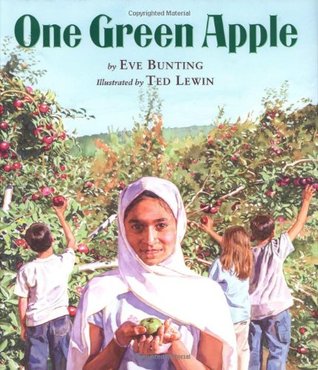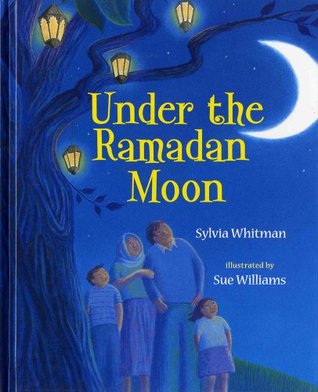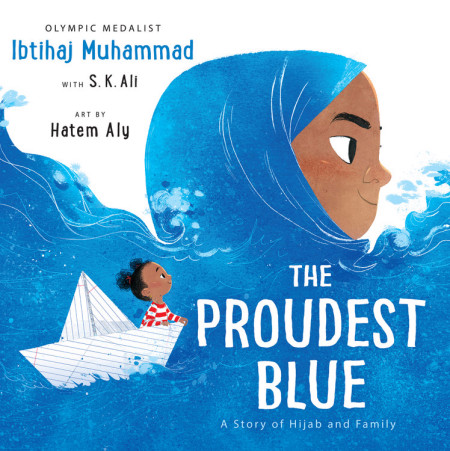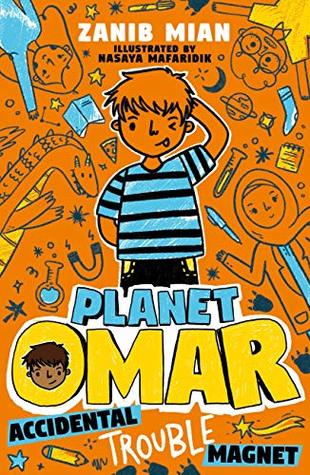By Donna Bulatowicz, Montana State University Billings, MT, and Desiree Cueto, Western Washington University, WA with Alicen Anijo
 Even though roughly 1% of U.S. adults identify as Muslim (Pew Research Center 2020), few books published in the United States authentically portray this community. This leads to challenges in finding books for Muslim children that represent their religious identity. It also poses a problem for non-Muslim children who need to see religious diversity represented in literature. Books are one way to mitigate prejudice; thus, the importance of a multitude of authentic portrayals of Muslim main characters in books can make a difference.
Even though roughly 1% of U.S. adults identify as Muslim (Pew Research Center 2020), few books published in the United States authentically portray this community. This leads to challenges in finding books for Muslim children that represent their religious identity. It also poses a problem for non-Muslim children who need to see religious diversity represented in literature. Books are one way to mitigate prejudice; thus, the importance of a multitude of authentic portrayals of Muslim main characters in books can make a difference.
Fifty-six percent of U.S. adults agree that Muslims face substantial discrimination in this country (Masci, 2019). My (Donna’s) first realization about the paucity of children’s books with Muslim main characters occurred nearly a decade ago. I overheard one of my elementary students repeating a damaging stereotype about Muslims. I talked with him, and I sought to further counteract the stereotypes that he — and very likely many of his classmates — had heard. Naturally, I turned to books.
 I scoured my classroom library, and I only had a few nonfiction books that taught about Islam. I looked in the school library, but didn’t fare any better. I ordered One Green Apple written by Eve Bunting and illustrated by Ted Lewin and Under the Ramadan Moon written by Sylvia Whitman and illustrated by Sue Williams. While reading these aloud helped counteract the stereotype that the child had repeated, I needed more. It was difficult to find children’s books with Muslim main characters.
I scoured my classroom library, and I only had a few nonfiction books that taught about Islam. I looked in the school library, but didn’t fare any better. I ordered One Green Apple written by Eve Bunting and illustrated by Ted Lewin and Under the Ramadan Moon written by Sylvia Whitman and illustrated by Sue Williams. While reading these aloud helped counteract the stereotype that the child had repeated, I needed more. It was difficult to find children’s books with Muslim main characters.
 Almost a decade later, multi-faceted, intersectional representations of Muslims in children’s books are still relatively rare, though the numbers have increased. Four years ago, a publishing imprint, Salaam Reads, was created to focus on publishing books with Muslim main characters. Given the importance of all children seeing authentic representations of minoritized characters, it is encouraging that there are more children’s books with Muslim main characters now than a decade ago, though the numbers are still low. Alicen Anijo, a student in Desiree’s class, grappled with issues of limited representation in books that featured Muslim characters. She found that there was a need for more diverse stories about Muslims, not just war, bullying, and pain. While she was pleased to find more books than she expected that featured Muslim characters, including recently published: The Proudest Blue: A Story of Hijab and Family by Ibtihaj Muhammad and Other Words for Home by Jasmine Warga; she was disappointed that nearly every story included the universal theme of bullying. Muslim characters were in one way or another rejected, which she felt contributed to the myth of the monolith. Why aren’t there more books with Muslim children just living their lives—unencumbered by war, resistance and ridicule?
Almost a decade later, multi-faceted, intersectional representations of Muslims in children’s books are still relatively rare, though the numbers have increased. Four years ago, a publishing imprint, Salaam Reads, was created to focus on publishing books with Muslim main characters. Given the importance of all children seeing authentic representations of minoritized characters, it is encouraging that there are more children’s books with Muslim main characters now than a decade ago, though the numbers are still low. Alicen Anijo, a student in Desiree’s class, grappled with issues of limited representation in books that featured Muslim characters. She found that there was a need for more diverse stories about Muslims, not just war, bullying, and pain. While she was pleased to find more books than she expected that featured Muslim characters, including recently published: The Proudest Blue: A Story of Hijab and Family by Ibtihaj Muhammad and Other Words for Home by Jasmine Warga; she was disappointed that nearly every story included the universal theme of bullying. Muslim characters were in one way or another rejected, which she felt contributed to the myth of the monolith. Why aren’t there more books with Muslim children just living their lives—unencumbered by war, resistance and ridicule?
 Recently, I (Donna) found a book that strikes a nice balance between the reality of bullying and the portrayal of a typical British childhood experience. I received a copy of Planet Omar: Accidental Trouble Magnet written by Zanib Mian and illustrated by Nasaya Mafaridik, an #ownvoices book originally published in Great Britain last year. Omar and his family recently moved, and he’s nervous about starting a new school. However, his teacher is nice, and he quickly makes a new best friend, Charlie. One of the children in his class starts bullying him, and Omar attempts to deflect the bullying with humor and imagination. His big imagination helps him navigate the changes and challenges in his life in this delightful middle grades book. Alicen also noticed that many children’s books with Muslim characters tend to focus on refugees and/or piousness. When speaking of the books about refugees, she mentioned that the representation is important, but cautioned that additional representations are essential so as not to perpetuate stereotypes. She also commented on the importance of multi-faceted representations where Muslim identity is not the main focus of the book. “However, it is incredibly difficult to find stories where the characters just happen to be Muslim and experience American life similarly to the non-Muslim kids.” She was able to find four books that did this: Yasmin series by Saadia Faruqi, illustrated by Hatem Aly; Big Red Lollipop by Rukhsana Khan, illustrated by Sophie Blackhall; Under My Hijab by Hena Khan, illustrated by Aaliya Jaleel; and Saints and Misfits by S.K. Ali.
Recently, I (Donna) found a book that strikes a nice balance between the reality of bullying and the portrayal of a typical British childhood experience. I received a copy of Planet Omar: Accidental Trouble Magnet written by Zanib Mian and illustrated by Nasaya Mafaridik, an #ownvoices book originally published in Great Britain last year. Omar and his family recently moved, and he’s nervous about starting a new school. However, his teacher is nice, and he quickly makes a new best friend, Charlie. One of the children in his class starts bullying him, and Omar attempts to deflect the bullying with humor and imagination. His big imagination helps him navigate the changes and challenges in his life in this delightful middle grades book. Alicen also noticed that many children’s books with Muslim characters tend to focus on refugees and/or piousness. When speaking of the books about refugees, she mentioned that the representation is important, but cautioned that additional representations are essential so as not to perpetuate stereotypes. She also commented on the importance of multi-faceted representations where Muslim identity is not the main focus of the book. “However, it is incredibly difficult to find stories where the characters just happen to be Muslim and experience American life similarly to the non-Muslim kids.” She was able to find four books that did this: Yasmin series by Saadia Faruqi, illustrated by Hatem Aly; Big Red Lollipop by Rukhsana Khan, illustrated by Sophie Blackhall; Under My Hijab by Hena Khan, illustrated by Aaliya Jaleel; and Saints and Misfits by S.K. Ali.
Masci, D. (2019). Many Americans see religious discrimination in the U.S.—especially against Muslims. Pew Research Center. https://www.pewresearch.org/fact-tank/2019/05/17/many-americans-see-religious-discrimination-in-u-s-especially-against-muslims/
Pew Research Center (2020). Religion &Public Life. https://www.pewforum.org/religious-landscape-study/#religions
Children’s Book References:
Ali, S.K. (2017). Saints and Misfits. New York, NY: Salaam Reads.
Bunting, E. (2006). One Green Apple. New York, NY: Clarion Books.
Faruqi: S. Yasmin series. Picture Window Books.
Khan, H. (2019). Under My Hijab. New York, NY: Lee & Low Books.
Khan, R. (2010). Big Red Lollipop. New York, NY: Viking Books for Young Readers.
Mian, Z. and Mafaridik, N. (2020). Planet Omar: Accidental Trouble Magnet. New York, NY:Penguin.
Whitman, S. (2011). Under the Ramadan Moon. Park Ridge, IL: Albert Whitman & Company.
Journey through Worlds of Words during our open reading hours: Monday-Friday, 9 a.m. to 5 p.m. and Saturday, 9 a.m. to 1 p.m. To view our complete offerings of WOW Currents, please visit its archival stream.
- Themes: Aaliya Jaleel, Alicen Anijo, Big Red Lollipop, Desiree Cueto, Donna Bulatowicz, Eve Bunting, Hatem Aly, Hena Khan, Ibtihaj Muhammad, Jasmine Warga, Muslim, Nasaya Mafaridik, One Green Apple, Other Words For Home, Planet Omar: Accidental Trouble Magnet, Proudest Blue: A Story of Hijab and Family, Rukhsana Khan, S.K. Ali, Saadia Faruqi, Saints and Misfits, Sophie Blackhall, Sue WIlliams, Sylvia Whitman, Ted Lewin, Under My Hijab, Under the Ramadan Moon, Yasmin, Zanib Mian
- Descriptors: Books & Resources, WOW Currents
